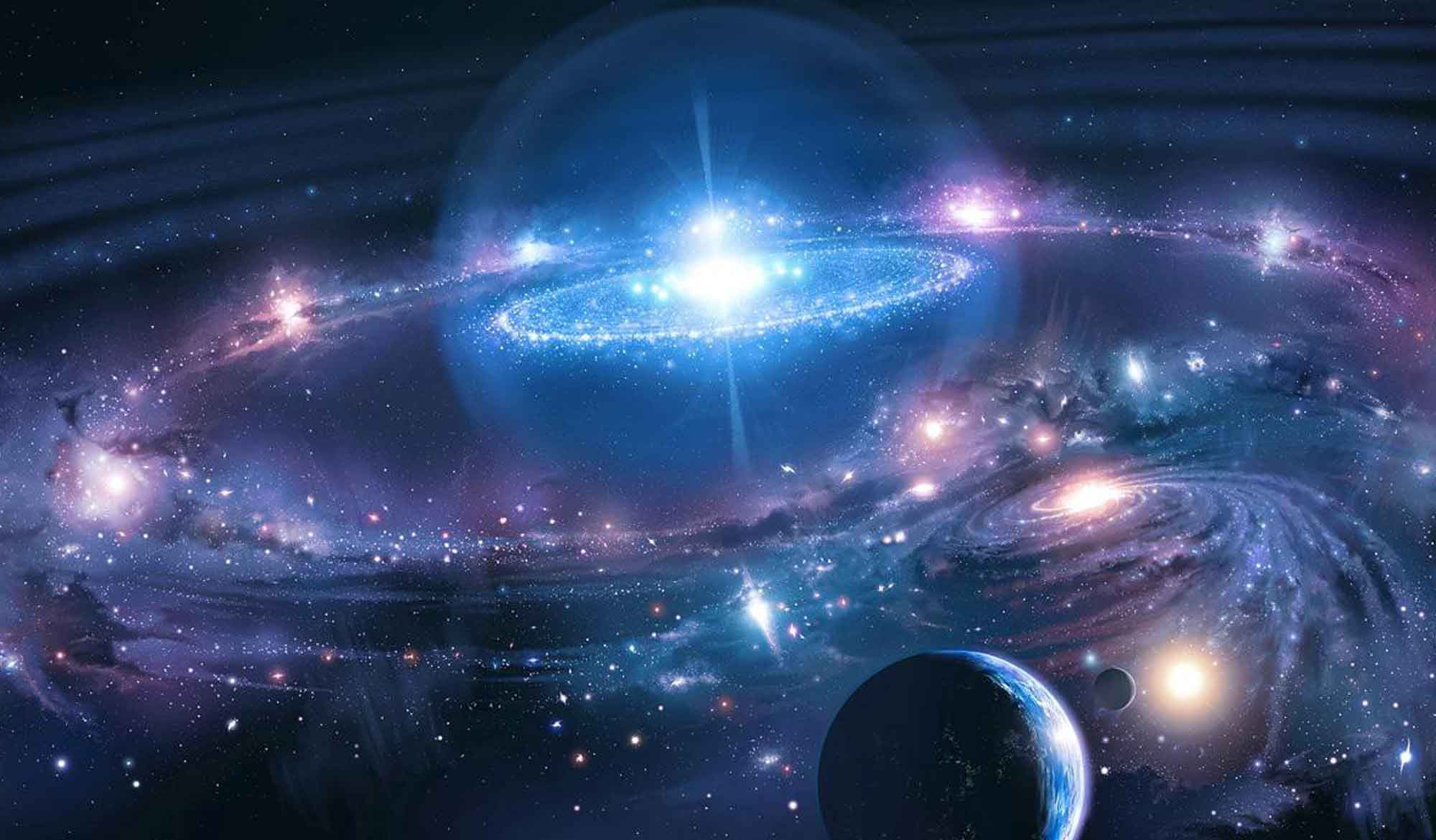Overview
‘Modern Science and the Vedas’ was written by Swami Narasingha in October 2009. In this article, Narasingha Maharaja explains that the scientific theories such as parallel universes, string theory and dark matter may already have been explained in the Vedas, and in particular, in the philosophical system of Sāṅkhya.
In 1959 two American atomic scientists, Dr. Emillo Segre and Dr. Owen Chamberlain were awarded the Nobel Prize in Physics for the discovery of the antiproton, proving (theoretically) that matter exists in two forms — as particles and antiparticles. According to one of the fundamental assumptions of the new theory, there may exist another world, or an anti-world, built up of anti-matter. This anti-material world would consist of atomic and subatomic particles spinning in reverse orbits to those of the world we know. If these two worlds should ever clash, they would both be annihilated in one blinding flash.
That same year (1959) A.C. Bhaktivedānta Swami Prabhupāda published a small essay, Easy Journey to Other Planets. He began this work by quoting the above information and went on to say that indeed, two worlds did exist, the material and the spiritual, but the nature of the spiritual world was that it could never be annihilated.
I first read Easy Journey to Other Planets in 1969 and for many years after that I wondered why there hadn’t been further research into the concept of antiparticles or anti-worlds. Almost 40 years later I was pleasantly surprised to learn that the theory of anti-worlds has been a hot topic of physics research all those years and remains so even today. In fact the anti-world theory now occupies a prominent place in theoretical physics as the Multiverse Hypothesis, sometimes known as Parallel Universes.
Parallel Universes
Progress however in the Multiverse Hypothesis hasn’t been much to write home about. Concepts keep changing and no one has yet to make actual contact with a Multiverse or Parallel Universe. In other words, there haven’t been any tangible results in the field of Multiverse research. But of course, the scientists (physicists) who are doing the research are worthy of respect, honour, great laudations and sizable salaries because, even though unable to actually ‘prove’ their theories, they are great and deserve the perks of greatness, because they are able to think about such lofty concepts. They are great minds.
But what about the writers and commentators of Vedic literature who spoke of the anti-material world (Paravyoma and Vaikuṇṭha) many centuries before the great minds of the west even realized that the Earth wasn’t flat! Aren’t those Vedic seers worthy of being counted as great thinkers, great minds and men of scientific fibre? If so, then why do we not give them their due and, more importantly, why do today’s scientists, physicists and researchers not pay closer attention to their ancient achievements? I don’t have the answer for that.
Let’s look at some of the Vedic concepts and achievements in addition to Parallel Universes that have become trends in modern scientific disciplines and even quintessential to science itself.
In Kapila-deva’s system of Sāṅkhya, the analytical study of material nature, matter develops from subtle to gross. The qualities of an element exist before the gross manifestation of the element. That is quite different than the way most of us think of matter. For example, aroma is the quality of earth and we therefore think that first there is the substance earth and then the aroma. But in the Sāṅkhya, or Vedic way of thinking, it is just the opposite. First there exists the quality of aroma and then earth is manifest – everything begins from the subtle plane and moves toward the gross.
The subtlest aspect of matter in Sāṅkhya is ‘vibration’ – also thought of as a sound vibration or frequency. That most subtle existence that precedes every and all aspects of matter is a vibration or sound called tan-mātrā. In layman’s terms, in Sāṅkhya, a vibration or sound lies at the basis of matter. Everything springs from that original vibration — the basis of everything lies in sound.
String Theory
Respectively, String Theory (a developing branch of theoretical physics that combines quantum mechanics and general relativity into a quantum theory of gravity) has connotations similar to the Sāṅkhya conception of tan-mātrā or sound vibration being the basis of matter.
Then there is the theoretical physics concerning Dark Matter or the missing mass in the universe. Physicists conclude, based on research, that as much as 80% of the mass of this universe has gone missing or is undetectable. Simply put, to account for the amount of gravity in the universe, 80% more matter than is visible is required. Where is it?
The first person to provide evidence and infer the existence of a phenomenon that has come to be called ‘dark matter’ was Swiss astrophysicist Fritz Zwicky, of the California Institute of Technology in 1933. Zwicky applied the viral theorem to the Coma cluster of galaxies and obtained evidence of unseen mass. Zwicky estimated the cluster’s total mass based on the motions of galaxies near its edge and compared that estimate to one based on the number of galaxies and total brightness of the cluster. He found that there was about 400 times more estimated mass than was visually observable. The gravity of the visible galaxies in the cluster would be far too small for such fast orbits, so something extra was required. This is known as the “missing mass problem”. Based on these conclusions, Zwicky inferred that there must be some non-visible form of matter that would provide enough of the mass and gravity to hold the cluster together. That was the beginning for the search for Dark Matter.
Dark Matter
Seventy-six years later, science is still looking for Dark Matter. They know it is literally everywhere, but it escapes detection and thus they are unable to observe it. Millions of taxpayer’s dollars are spent every year by western super powers in the search for Dark Matter. Nothing has turned up yet.
On a parallel platform, Sāṅkhya identifies a material element that among its other qualities is, for the most part, elusive (emphasis on elusive). It is everywhere (all-pervading) but at the same time undetectable (ethereal). That element in Sāṅkhya is called nabha, or as mentioned in Bhagavad-gītā, kham.
The activities/qualities and characteristics of the kham element in Sāṅkhya can be observed as accommodating space/room for existence. Space itself, both internal and external, is the element kham. This then, if taken notice of by physicists, may very well fit nicely into the ‘missing mass problem’. Kham, being a material element, could theoretically be assigned a numerical code in the periodic table of elements like everything else – then they might find what they are looking for.
In the Vedic way of thinking the physical element is secondary to its qualities — when the qualities of a particular thing are understood, it is as good as or better than having the grosser subject at hand. In that sense modern science has already discovered Dark Matter, because they have understood something of its qualities… they just haven’t realized it yet.
In the Śrīmad Bhāgavatam we find the following verse:
bhūtānāṁ chidra-dātṛtvaṁ bahir antaram eva ca
prāṇendriyātma-dhiṣṇyatvaṁ nabhaso vṛtti-lakṣaṇam
“The activities and characteristics of the ethereal element can be observed as accommodation for the room for the external and internal existences of all living entities, namely the field of activities of the vital air, the senses and the mind.” (Bhāg. 3.26.34)
In his purport to this verse, A.C. Bhaktivedānta Swami Prabhupāda says that the Sāṅkhya understanding of nabha or kham (that he has called in English ‘the ethereal element’) is the basis for great scientific research:
This verse is the potential basis of great scientific research work, for it explains how subtle forms are generated from the ethereal element (nabha), what their characteristics and actions are, and how the tangible elements, namely air, fire, water and earth, are manifested from the subtle form.
Sāṅkhya does not simply list the basic material elements, but it explains quite scientifically how those elements evolve from the subtlest plane of existence up to the divisions of the universe — this is quite elaborate and scientific indeed.
Yet for science to take full advantage of the Sāṅkhya understanding of matter and to discover how the universe came into being, they will have to do more than just add kham/nabha to their list of elements, they will have to add ahaṅkāra (ego), mana (the mind) and buddhi (intelligence) to their table of elements for, indeed, Sāṅkhya lists these as material elements. However, these elements ahaṅkāra, mana and buddhi are categorized as even more subtle than kham, because they are closer in character to ātmā, consciousness.
Beyond the gross and subtle material elements being added to the scientific table of elements, Sāṅkhya says that a complete understanding of existence, of reality, is not possible without adding two transcendental, anti-material concepts – namely ātmā and Paramātmā (consciousness and super-consciousness). This, it seems, science struggles with even more than Dark Matter. We have dubbed it ‘Light Matter’.
The most intriguing physics discovery by far has to be the theory of the Warp Drive or the Alcubierre Drive, named after its inventor, the Mexican theoretical physicist Miguel Alcubierre Moya. Most of us know about the Warp Drive from science fiction movies like Star Trek and Contact, but Moya had the real deal.
In his 1994 physics paper, Moya proposed a method of stretching space in a wave that would in theory cause the fabric of space ahead of a spacecraft to contract and the space behind it to expand.
The ship would ride this wave inside a region known as a warp bubble of flat space. Since the ship is not moving within this bubble, but carried along as the region itself moves, conventional relativistic effects such as time dilation do not apply in the way they would in the case of a ship moving at high velocity through flat space-time. Also, this method of travel does not actually involve moving faster than light in a local sense, since a light beam within the bubble would still always move faster than the ship; it is only ‘faster than light’ in the sense that, thanks to the contraction of the space in front of it, the ship could reach its destination faster than a light beam restricted to traveling outside the warp bubble. Thus, the Alcubierre drive does not contradict the conventional claim that relativity forbids a slower-than-light object to accelerate to faster-than-light speeds.
Pretty neat stuff – and NASA certainly thought so, mounting their ‘Time Warp’ program at a cost of many millions of dollars for more than a decade before they finally gave it up. “Yes, Time Warp is possible.” they said, “We just can’t do it!” Shucks!
But we are not surprised to find this same theory mentioned many thousands of years ago in the Vedic literature as a siddhi, or mystic perfection, by which one can travel to another planet or another galaxy without conventional propulsion and in zero time.
One may argue that although this is mentioned in the Vedas, it is doubtful that they were able to do it. That argument could be applied, but first one should realize that they could think about it thousands of years before NASA. Whether they could do it or not is irrelevant. After all, NASA was only thinking about it – they never actually did it either.
See the fun – the Vedic knowledge is easily dismissed or not recognised at all. These are simply stories and myths they say, but theoretical physics/science — now that’s something you can believe in!
It might be fair to ask, “Who writes this stuff?” Have the intelligent people in this world forgotten how to think for themselves? Have we simply become the faithful followers of whatever ‘science’ has to say? Have we lost our reason and logic? Apparently some have!
If we were to list all the scientific discoveries that Vedic civilization has given to the world, some in common use today like the one, the zero, the binary system, calculations regarding astronomical phenomena and more yet to be discovered or understood like the Warp Drive theory, then this article would become a book. So here we stop.
Related Articles & Books
- 📖 When Wise Men Speak Wise Men Listen by Swami B.G. Narasiṅgha Mahārāja (Book)
- Vedic Global Civilisation by Śrīla Bhakti Gaurava Narasiṅgha Mahārāja
- UFOs – Is Anyone Out There? by Śrīla Bhakti Gaurava Narasiṅgha Mahārāja
- Modern Science and the Vedas by Śrīla Bhakti Gaurava Narasiṅgha Mahārāja
- Giants – Myth or Fact? by Śrīla Bhakti Gaurava Narasiṅgha Mahārāja
- Timiṅgila – Myth or Fact? by Śrīla Bhakti Gaurava Narasiṅgha Mahārāja
- Makara – Myth or fact? by Śrīla Bhakti Gaurava Narasiṅgha Mahārāja
- Lost Ancient Technology by Kalki Dāsa
- Here Be Dragons! by Kalki Dāsa
- The Great Flood – Are Manu and Noah the Same Person? by Kalki Dāsa
- Zarathustra and The De-evolution of Theism by Kalki Dāsa
- Did Darwin Borrow His Theory of Evolution from the Vedas? by Kalki Dāsa
Further Reading
Prema Dhāma Deva Stotram with the Narasiṅgha Sevaka Commentary – Verses 61-65
In verses 61 to 65 of 'Prema Dhāma Deva Stotram', Śrīla Śrīdhara Mahārāja narrates the pastime of Śrī Caitanya at Caṭaka Parvata In Purī and explains how the scriptures produced by Brahmā and Śiva are ultimately searching for the personality of Mahāprabhu who is merciful too all jīvas, no matter what their social position.
Prabhupāda Śrīla Sarasvatī Ṭhākura’s Visit to Ayodhyā
With the forthcoming observance of Śrī Rāma Navamī, we present 'Prabhupāda Śrīla Sarasvatī Ṭhākura’s Visit to Ayodhyā' written by Śrīla Bhaktisiddhānta Sarasvatī Ṭhākura Prabhupāda from The Gaudīyā magazine, Vol 3. Issue 21/ In December 1924, after visiting Benares and Prāyāga, Sarasvatī Ṭhākura visited the birth-site of Śrī Rāmācandra in Ayodhyā.
Śaraṇāgati – The Only Path to Auspiciousness
In this article, 'Śaraṇāgati - The Only Path to Auspiciousness', Dhīra Lalitā Dāsī analyses the process of śaraṇāgati (surrender) beginning with śraddhā (faith). She also discusses the role of śāstra and the Vaiṣṇava in connection with surrender.
Ātma Samīkṣā – The Value of Introspection
In this article, "Ātma Samīkṣā – The Value of Introspection" Kalki Dāsa highlights the importance of introspection in the life of a devotee and especially in relation to the worldly environment that surrounds us. He also explains how transcendental sound influences our capacity to introspect.
Prema Dhāma Deva Stotram with the Narasiṅgha Sevaka Commentary – Verses 61-65
In verses 61 to 65 of 'Prema Dhāma Deva Stotram', Śrīla Śrīdhara Mahārāja narrates the pastime of Śrī Caitanya at Caṭaka Parvata In Purī and explains how the scriptures produced by Brahmā and Śiva are ultimately searching for the personality of Mahāprabhu who is merciful too all jīvas, no matter what their social position.
Prabhupāda Śrīla Sarasvatī Ṭhākura’s Visit to Ayodhyā
With the forthcoming observance of Śrī Rāma Navamī, we present 'Prabhupāda Śrīla Sarasvatī Ṭhākura’s Visit to Ayodhyā' written by Śrīla Bhaktisiddhānta Sarasvatī Ṭhākura Prabhupāda from The Gaudīyā magazine, Vol 3. Issue 21/ In December 1924, after visiting Benares and Prāyāga, Sarasvatī Ṭhākura visited the birth-site of Śrī Rāmācandra in Ayodhyā.
Śaraṇāgati – The Only Path to Auspiciousness
In this article, 'Śaraṇāgati - The Only Path to Auspiciousness', Dhīra Lalitā Dāsī analyses the process of śaraṇāgati (surrender) beginning with śraddhā (faith). She also discusses the role of śāstra and the Vaiṣṇava in connection with surrender.
Ātma Samīkṣā – The Value of Introspection
In this article, "Ātma Samīkṣā – The Value of Introspection" Kalki Dāsa highlights the importance of introspection in the life of a devotee and especially in relation to the worldly environment that surrounds us. He also explains how transcendental sound influences our capacity to introspect.








